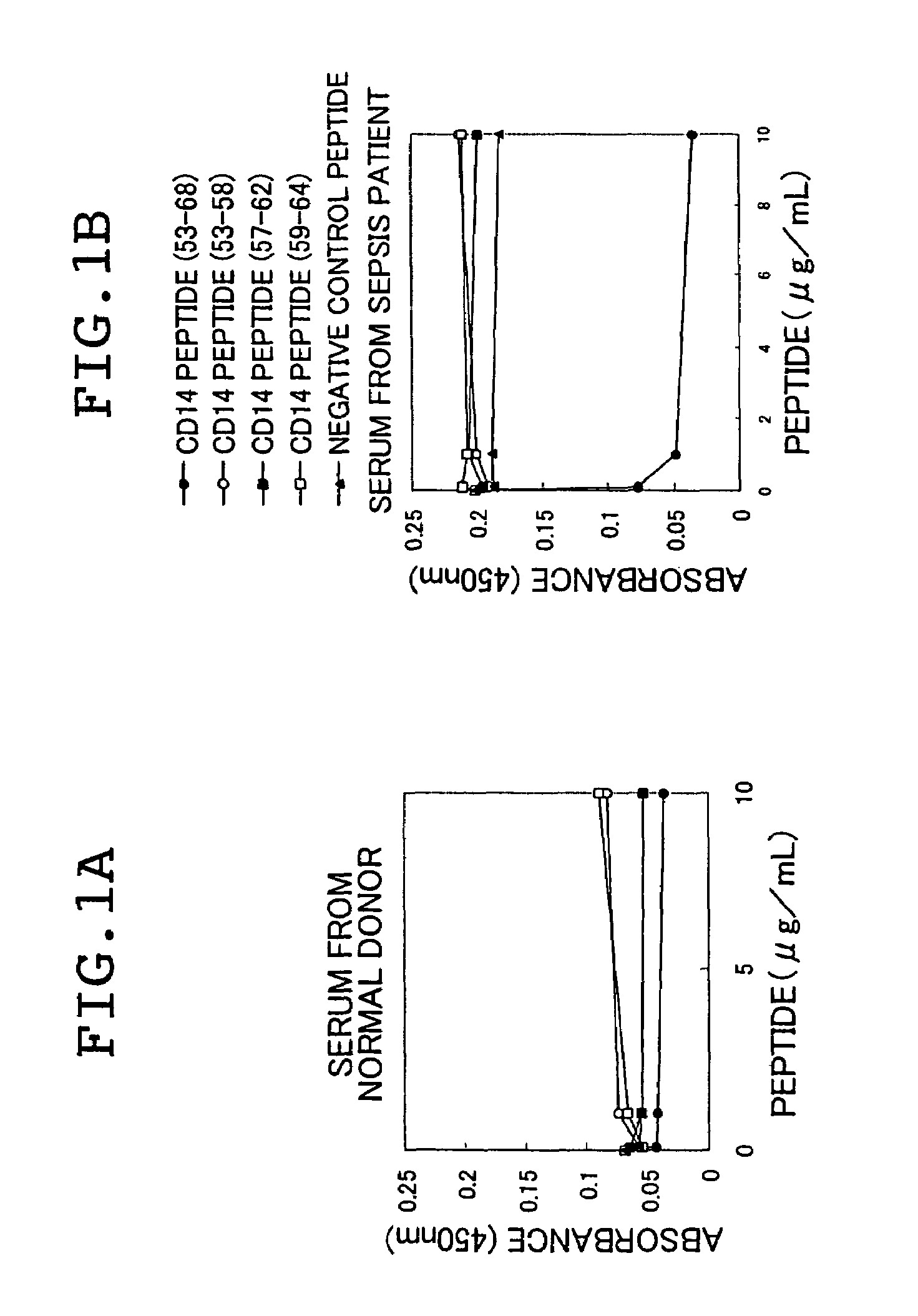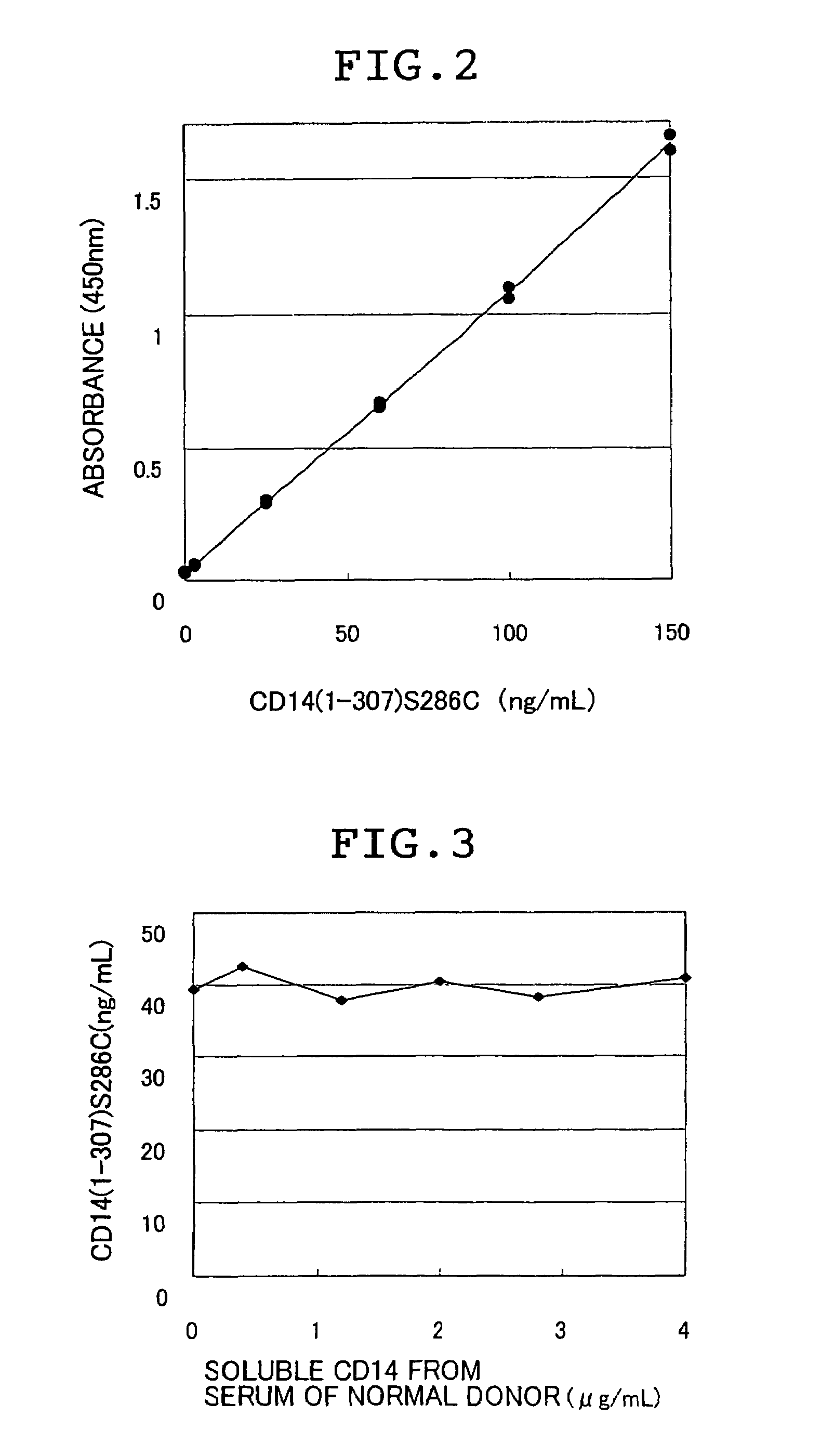Soluble CD14 antigen
a technology of soluble cd14 and antigen, which is applied in the field of in vivo antigen, can solve the problem that soluble cd14 has not been provided as a diagnostic product for sepsis
- Summary
- Abstract
- Description
- Claims
- Application Information
AI Technical Summary
Benefits of technology
Problems solved by technology
Method used
Image
Examples
example 1
Preparation of Polyclonal Antibody Using Synthetic Peptide as Antigen
1-(1) Preparation of Peptide as Antigen
[0474]To bind a peptide having the sequence described in SEQ ID NO: 2 (corresponding to a sequence at positions 53 to 68 described in SEQ ID NO: 3) (hereinafter, described as S68 peptide) to a carrier protein at the N-terminal thereof through an SH group, the peptide was synthesized by inserting cysteine into the N-terminal. That is, using a peptide synthesizer ABI433A (Applied), amino acid columns were aligned according to the amino acid sequence and an amino acid column for cysteine was placed on the N-terminal, followed by conducting automatic synthesis. The synthesized peptide was cut out from a resin by a conventional procedure and was then precipitated with ethyl ether, recovered, and dissolved in distilled water again, followed by freeze drying. After the resulting crude peptide had been dissolved, the peptide was eluted with a linear gradient of 5-70% acetonitrile conc...
example 2
Preparation of Monoclonal Antibody Using Synthetic Peptide as Antigen
[0479]20 μg of S68 peptide-KLH prepared in Example 1-(2) was dissolved in 100 μL of physiological saline and mixed with an equivalent amount of Freund's complete adjuvant (DIFCO), followed by administering 100 μL of the mixture to each of the rear foot pads of a female Wister rat aged 8 weeks. After 2 weeks, the iliac lymph node was surgically excised and cell fusion was performed. The cell fusion was conducted according to Tamie Ando and Takeshi Chiba: “Introduction to Monoclonal Antibody Experimental Manipulation”, page 83, 1991 (Kodansha Ltd.). In other words, lymphocytes were separated from the lymph node using a cell strainer (Falcon) and mixed with myeloma cells (Sp2 / O—Ag14) at a ratio of 5:1, followed by cell fusion using polyethylene glycol. Fused cells were suspended in an HAT medium and hybridomas were selected, followed by screening hybridomas producing the target antibody.
[0480]The screening was perform...
example 3
Study of Assay System with Sandwich EIA Method
[0484]Using the antibodies described in Examples 1 and 2, the assay system with a sandwich EIA method was studied.
3-(1) Preparation of Recombinant Human CD14
[0485]First, for preparing a monoclonal antibody against rsCD14(1-285) to be used as a second antibody in the sandwich ELISA method, rsCD14(1-285) as an immunogen was prepared in E. coli. In order to express rsCD14(1-285) in E. coli, an expression plasmid pTrp1659 was constructed by the following method.
[0486]First, oligomer 8, links (5′-agc tta gga att t-3′) (SEQ ID NO: 7) and oligomer 8, linkA (5′-cta gaa att cct a-3′) (SEQ ID NO: 8) were synthesized.
[0487]Those oligomers were mixed in equivalent amounts and heated at 99° C. for 1 minute, and the mixture was then annealed by gradually cooling it down to room temperature. Furthermore, 5′-terminal thereof was phosphorylated by T4 Polynucleotide Kinase to prepare a linker.
[0488]Next, sense primer A (5′-aca tct aga tga cca cgc cag aac ...
PUM
| Property | Measurement | Unit |
|---|---|---|
| molecular weight | aaaaa | aaaaa |
| molecular weight | aaaaa | aaaaa |
| molecular weight | aaaaa | aaaaa |
Abstract
Description
Claims
Application Information
 Login to View More
Login to View More - R&D
- Intellectual Property
- Life Sciences
- Materials
- Tech Scout
- Unparalleled Data Quality
- Higher Quality Content
- 60% Fewer Hallucinations
Browse by: Latest US Patents, China's latest patents, Technical Efficacy Thesaurus, Application Domain, Technology Topic, Popular Technical Reports.
© 2025 PatSnap. All rights reserved.Legal|Privacy policy|Modern Slavery Act Transparency Statement|Sitemap|About US| Contact US: help@patsnap.com



